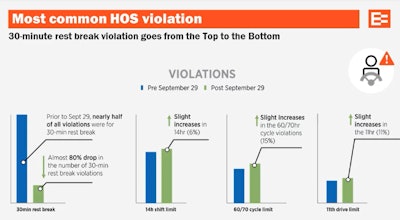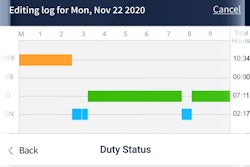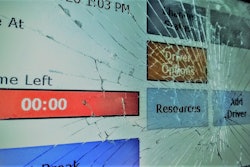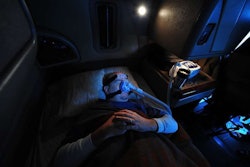The grace periods for expired CDLs and related credentials, extended repeatedly during the COVID-19 pandemic, are coming to an end, said a Federal Motor Carrier Safety Administration official.
The update was given Tuesday by Joe DeLorenzo, director of FMCSA‘s Office of Enforcement & Compliance, during a virtual User Summit hosted by ERoad, an electronic logging device provider. He emphasized for carriers, owner-operators and other drivers that the intention when it comes to expired CDLs, medical certification renewals, hazmat endorsements and more is to get back on schedule with the sunset of the most recently issued waiver. That one extended everything out through the end of the year after a series of one-month extensions.
“When we published that last extension,” he said, “we said, ‘Don’t expect us to issue another extension.'” The hope is to return to normal schedules as it feels like most “everybody’s kind of figured out how to function in the current environment” with COVID-19 and new distancing protocols and the like.
DeLorenzo, however, didn’t rule out a change considering the bedrock COVID situation, increasingly dire in terms of rate of spread, and states’ licensing arms’ ability to carry out renewals safely and effectively. “We’re continuing to monitor the situation as it changes daily. If we see there’s continuing problems, we’ll reconsider” the deadline.
Running short-haul? You’re still limited by the hours of service
 From left: ERoad’s Soona Lee, Joe DeLorenzo of FMCSA and CVSA’s Kerri Wirachowsky
From left: ERoad’s Soona Lee, Joe DeLorenzo of FMCSA and CVSA’s Kerri WirachowskyDeLorenzo was joined in the Q&A with ERoad’s Soona Lee and by Kerri Wirachowsky, the Commercial Vehicle Safety Alliance’s roadside inspections director. Lee presented ERoad’s ELD systems’ flagged potential hours of service violations tallied one month prior to and after the Sept. 29 changes aimed at introducing flexibility into drivers’ hours options.
As have other ELD providers, Lee showed a dramatic drop-off in potential 30-minute-break infractions recorded therein, but also a slight uptick in violations of the 11-hour driving limit, the 14-hour driving window and the 60/70-hour cumulative duty limitations on driving.
 “That’s something we expected and hoped to see,” noted DeLorenzo, speaking to this ERoad slide and the large fall-off in potential 30-minute break violations. As of Sept. 29, drivers can newly satisfy the requirement with an on-duty not driving status in addition to off-duty, and the requirement to take a break is within the first eight driving hours, not on-duty hours as before.
“That’s something we expected and hoped to see,” noted DeLorenzo, speaking to this ERoad slide and the large fall-off in potential 30-minute break violations. As of Sept. 29, drivers can newly satisfy the requirement with an on-duty not driving status in addition to off-duty, and the requirement to take a break is within the first eight driving hours, not on-duty hours as before.DeLorenzo and Wirachowsky noted that increases in potential cycle violations reported by ERoad, however slight, could possibly be a function of the expanded daily window for short-haul drivers — from 12 to 14 hours.
Wirachowsky pointed to a common misconception that’s been battled by advisers and enforcement personnel: that the short-haul exception is an exemption to the hours of service themselves. “That’s been a mistaken impression forever,” she said.
The short-haul rule, however, is merely an exemption from having to keep a standardized log book. Time records are still kept and 11-hour drive limits and cumulative duty limitations still apply (representing the two biggest violation-category increases shown above).
Said Wirachowsky, “With the local drivers, many people think that when they’re exempt from a log, they’re exempt from hours of service. They’re thinking they’re bound by 14 hours [under the new rule, up from 12] and they don’t have to be bound by the 11-hour rule. … Because you’re on short-haul doesn’t mean that you are exempt from the hours of service.”
The rule-change to expand the air mile radius (the qualifying feature for the short-haul exemption) from 100 to 150 air miles has furthermore led a 47 percent increase in the number of ERoad ELD users who are using the short-haul exception at least some of the time.
For DeLorenzo, those drivers likely represent ERoad’s overall slight uptick in potential duty and drive violations, he believed, in addition to what Lee showed was an increase in 11-hour violations specifically by drivers using the short-haul exception. With the time limit for such drivers set at 12 hours, “drivers didn’t have [as much] room to drive more than 11 hours in the short-haul window of 12 hours,” DeLorenzo said. Before it was 14, “they didn’t really have to worry about it.”
Hours of service and other points of emphasis
- Split sleeper berth use is up, as reported elsewhere, among ELD users since FMCSA expanded available options to include a minimum 7/3-hour split pair. Prior rules allowed up to 8/2. Part of the reason could be attributable to the new 14-hour-clock pause value of the shorter of the two split pairs, yet Lee noted that drivers don’t often seem to be utilizing pairs that were a minimum 7/3.
- The new split sleeper is as challenging for enforcement as it is for some newbie drivers, Wirachowsky said. “It’s new, and anything new requires training and understanding.” While inspectors’ eRODS software has been updated to accommodate an electronic assist to them when inspecting logs, that software can be challenging. At the same time, Wirachowsky noted that she hasn’t “heard from enforcement that they’re seeing a huge increase” in drivers using the splits. For carriers, “it takes time to coordinate this into their operational patterns. Over time, you’ll see the motor carrier community learn how to use it to their benefit” for efficiency, she believes.
- The FMCSA’s relatively new Crash Preventability Determination Program has received approximately 10,000 DataQs requests since its inception, said DeLorenzo. The program offers carriers the ability to have certain kinds of crashes, when deemed non-preventable, removed from computation of safety scores, and the non-preventable determination is reflected on their record. Of those 10,000 requests, “we’re showing 97 percent … not being the responsibility of the carrier.” That’s potential proof that a “theory floating around for years about certain types of crashes has turned out to be true. A majority [of the crash types] are rear-end crashes.” Now, FMCSA “can adjust [those qualifying non-preventable crashes for carriers] in the SMS – and have it reflected in their score.”
- A newly updated inspection bulletin and online course are available to any CVSA member looking to better understand ELDs’ output files (what enforcement sees, in the end), Wirachowsky said. The original bulletin, produced in 2017 and numbered “2017-05,” is specific to the ELD mandate rule. It was updated this fall “to incorporate issues that we’ve all seen with regard to the ELD output file and what happens to it when it’s transferred,” from dropped VIN numbers or inexplicable unassigned driving miles with power interruptions and more. The special course is available to CVSA members via what Wirachowsky called the alliance’s “learning management system.” Contact CVSA for more info.










